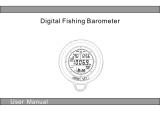
Table of Contents
Introduction.................................................................... 1
Getting Started........................................................................... 1
Charging the Device.............................................................. 1
Keys...................................................................................... 1
Sensors...................................................................................... 1
Viewing the Sensor Data....................................................... 1
Turning on a Sensor Mode.................................................... 2
Acquiring Satellites.................................................................... 2
Stopping GPS....................................................................... 2
Going for a Hike......................................................................... 2
Sending Your Hike to BaseCamp™...................................... 2
Profiles....................................................................................... 2
Changing Profiles.................................................................. 2
Creating a Custom Profile..................................................... 2
Deleting a Profile................................................................... 3
Waypoints, Routes, and Tracks ...................................3
Waypoints.................................................................................. 3
Creating a Waypoint.............................................................. 3
Finding a Waypoint by Name................................................ 3
Finding Nearby Locations..................................................... 3
Navigating to a Waypoint...................................................... 3
Editing a Waypoint................................................................ 3
Increasing the Accuracy of a Waypoint Location.................. 3
Projecting a Waypoint........................................................... 3
Deleting a Waypoint.............................................................. 3
Deleting All Waypoints.......................................................... 3
Routes........................................................................................ 4
Creating a Route................................................................... 4
Editing the Name of a Route................................................. 4
Editing a Route...................................................................... 4
Viewing a Route on the Map................................................. 4
Deleting a Route................................................................... 4
Reversing a Route................................................................ 4
Tracks........................................................................................ 4
Recording a Track................................................................. 4
Saving the Current Track...................................................... 4
Viewing Details about the Track............................................ 4
Clearing the Current Track.................................................... 4
Deleting a Track.................................................................... 4
Sending and Receiving Data Wirelessly.................................... 4
Garmin Adventures.................................................................... 4
Navigation.......................................................................5
Navigating to a Destination........................................................ 5
Navigating with Sight 'N Go....................................................... 5
Compass.................................................................................... 5
Calibrating the Compass....................................................... 5
Map............................................................................................ 5
Browsing the Map................................................................. 5
Navigating Using TracBack®..................................................... 5
Altimeter and Barometer............................................................ 6
Calibrating the Barometric Altimeter..................................... 6
Tracking Weather Changes Overnight.................................. 6
Marking and Starting Navigation to a Man Overboard
Location..................................................................................... 6
Geocaches...................................................................... 6
Downloading Geocaches........................................................... 6
Navigating to a Geocache.......................................................... 6
Logging the Attempt................................................................... 6
chirp™........................................................................................ 6
Finding a Geocache with a chirp........................................... 6
Applications................................................................... 6
Clock.......................................................................................... 6
Setting the Alarm
................................................................... 6
Starting the Countdown Timer.............................................. 6
Using the Stopwatch............................................................. 7
Adding a Custom Time Zone................................................ 7
Editing a Custom Time Zone................................................. 7
Alerts.......................................................................................... 7
Setting a Proximity Alarm...................................................... 7
Calculating the Size of an Area.................................................. 7
Viewing the Almanacs................................................................ 7
Viewing Satellite Information...................................................... 7
Simulating a Location............................................................ 7
Customizing Your Device..............................................7
Setup Overview.......................................................................... 7
Customizing the Main Menu.................................................. 8
Customizing the Arrow Keys...................................................... 8
Customizing the Data Pages..................................................... 8
System Settings......................................................................... 8
About UltraTrac..................................................................... 8
Compass Settings...................................................................... 8
Setting the North Reference.................................................. 8
Altimeter Settings.................................................................. 9
Setting the Device Tones........................................................... 9
Display Settings......................................................................... 9
Map Settings.............................................................................. 9
Track Settings............................................................................ 9
Time Settings............................................................................. 9
Changing the Units of Measure................................................. 9
Position Format Settings............................................................ 9
Fitness Settings......................................................................... 9
Setting Your Fitness User Profile.......................................... 9
About Lifetime Athletes....................................................... 10
Geocache Settings................................................................... 10
Fitness.......................................................................... 10
Customizing Your Running or Cycling Profile.......................... 10
Going for a Run........................................................................ 10
History...................................................................................... 10
Viewing an Activity.............................................................. 10
Saving an Activity as a Track.............................................. 10
Deleting an Activity.............................................................. 10
Using Garmin Connect........................................................ 10
ANT+ Sensors.............................................................. 10
Pairing ANT+ Sensors............................................................. 10
tempe....................................................................................... 10
Putting On the Heart Rate Monitor........................................... 10
About Heart Rate Zones..................................................... 11
Fitness Goals...................................................................... 11
Setting Your Heart Rate Zones........................................... 11
Tips for Erratic Heart Rate Data.......................................... 11
Foot Pod.................................................................................. 11
Setting the Foot Pod Mode................................................. 11
Going for a Run Using a Foot Pod...................................... 11
Foot Pod Calibration........................................................... 12
Calibrating Your Foot Pod by Distance............................... 12
Calibrating Your Foot Pod by GPS..................................... 12
Calibrating Your Foot Pod Manually................................... 12
Using an Optional Bike Cadence Sensor................................. 12
Device Information.......................................................12
Viewing Device Information..................................................... 12
Updating the Software............................................................. 12
Device Care............................................................................. 12
Cleaning the Device............................................................ 12
Specifications........................................................................... 12
Heart Rate Monitor Specifications........................................... 12
Battery Information................................................................... 12
Heart Rate Monitor Battery...................................................... 12
Table of Contents i






















